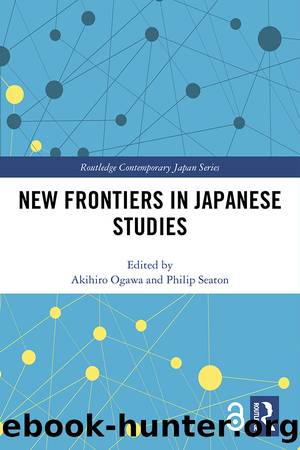New Frontiers in Japanese Studies by Ogawa Akihiro; Seaton Philip;

Author:Ogawa, Akihiro; Seaton, Philip;
Language: eng
Format: epub
Publisher: Taylor & Francis Group
Published: 2020-04-15T00:00:00+00:00
8 Immigrants caring for other immigrants
The case of the Kaagapay Oita Filipino Association
Melvin Jabar
Most research on Filipino immigrants in Japan is now heavily focused on formal caregiving work (e.g. Chapter 7 by Navallo in this volume; Imamura, Saito and Miyagi 2010). This is understandable, as the tides have shifted in another direction. In the past, Filipina women thrived in the Japanese entertainment industry. Today, many of them engage in caregiving work. In fact, Filipina women in JapaneseâFilipino marriages are ideally positioned to be hired as care workers, as they can speak relatively good Japanese and have permanent visas. Instead of hiring someone from the Philippines, it is economically feasible to recruit immigrants who are already in Japan. While much research is now geared towards this direction, this chapter takes a different approach by looking at how Filipina women provide care to their fellow Filipino immigrants. The aim of this chapter is to describe the role of a specific Catholic Church-based organisation of Filipino immigrants (specifically Filipina wives of Japanese husbands) in Japan in providing care to their fellow Filipino immigrants. Instead of focusing on the role of the Catholic Church in providing support to Filipino immigrants, this chapter highlights the role of a church-based Filipino organisation in providing care, not necessarily in the context of religious institutional care initiatives. Care in this regard is not limited to health care but also extends to spiritual, psychological and financial care.
This chapter argues that âethno-religiousâ organisations such as the Kaagapay Oita Filipino Association play a crucial role in providing care to immigrants from their respective ethnic backgrounds, given the absence of immediate family members to provide them with informal care. While they have their own family members from their families of procreation, it seems that Filipina immigrants still crave the Filipino way of providing care. While the host state can provide health and medical care, there are culture-specific care needs that can only be attended to by individuals or institutions that are sensitive to such cultural details. Differences in the provision of care can be due to language, religion or cultural practices. In this chapter, I would like to add to the scant literature on Filipino organisations in Japan providing care to fellow Filipino immigrants and their impacts on their well-being. In addition, this chapter also addresses a gap in the research on ethnic organisations. Most studies focus only on the role of such organisations in integration and the forging of networks among immigrants, for example the case of immigrants in Canada (e.g. Ho 2018). This chapter attempts to paint in broad strokes how organisations such as the Kaagapay Oita Filipino Association are trying to make themselves relevant to the lives of Filipino immigrants who have lived in Japan for years, by providing care to them in relation to health, ageing and death.
My argument is that it is about time we looked at the life trajectories of immigrants, not only by focusing on how ethnic- or nationality-based organisations such as the Kaagapay can
Download
This site does not store any files on its server. We only index and link to content provided by other sites. Please contact the content providers to delete copyright contents if any and email us, we'll remove relevant links or contents immediately.
| Africa | Americas |
| Arctic & Antarctica | Asia |
| Australia & Oceania | Europe |
| Middle East | Russia |
| United States | World |
| Ancient Civilizations | Military |
| Historical Study & Educational Resources |
The Story of China by Michael Wood(907)
Mr. Selden's Map of China by Timothy Brook(756)
Philippines--Culture Smart! by Culture Smart!(640)
Heroic Hindu Resistance To Muslim Invaders (636 AD to 1206 AD) by Sita Ram Goel(639)
Akbar: The Great Mughal by Ira Mukhoty(632)
The Meaning of India by Raja Rao(617)
Vedic Physics: Scientific Origin of Hinduism by Raja Ram Mohan Roy(607)
Banaras by Diana L. Eck(599)
India--Culture Smart! by Becky Stephen(585)
Food of India by unknow(585)
China Unbound by Joanna Chiu(580)
Mao's Great Famine: The History of China's Most Devastating Catastrophe, 1958-1962 by Frank Dikötter(576)
North of South by Shiva Naipaul(561)
Insurgency and Counterinsurgency by Jeremy Black(550)
A History of Japan by R.H.P. Mason & J.G. Caiger(546)
How to Be a Modern Samurai by Antony Cummins(545)
First Platoon by Annie Jacobsen(545)
The Genius of China: 3,000 Years of Science, Discovery, and Invention by Robert Temple(540)
The Digital Silk Road by Jonathan E. Hillman(528)
